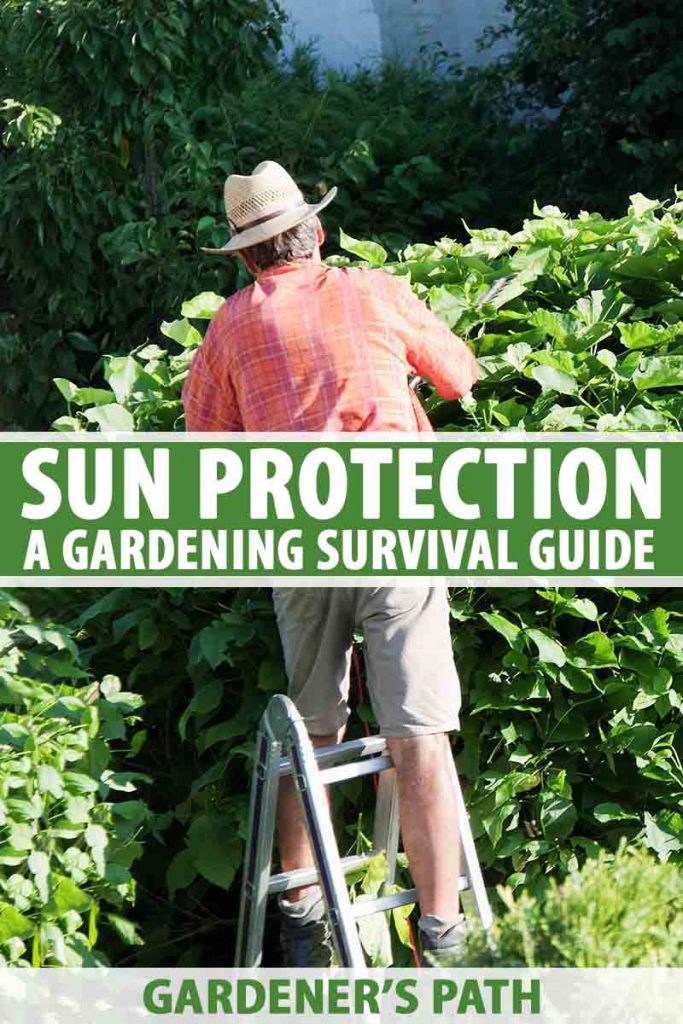Time spent in the garden is often time in the sun. And if you aren’t prepared for the heat, it’ll kick your booty!
The seasoned gardeners out there are probably nodding along with me right now, but for those first breaking ground on their backyard, garden plot, or allotment, this might come as news to you.
Isn’t spending time outdoors meant to be a refreshing break from the nonstop noise of the world?
It sure is! But, man, does it get hot out.

We link to vendors to help you find relevant products. If you buy from one of our links, we may earn a commission.
And many hours toiling over your flowers and veggies without protection can leave you susceptible to sunburn – and its damaging effects on your skin.
Knowing how to beat the heat and protect yourself from the sun’s damaging rays is a key component to enjoying your time in the garden – and not giving up when the sweat starts to drip.
Read on to see what beating the heat is all about, and to gain vital knowledge about sun safety.
Sun 1, Gardener 0
Years ago, I hired somebody who was new to the gardening world.
I asked if she was up to the challenge of spending time in the heat, and she replied quite smugly that she loved spending time on the beach in the sun, so she’d be just fine.
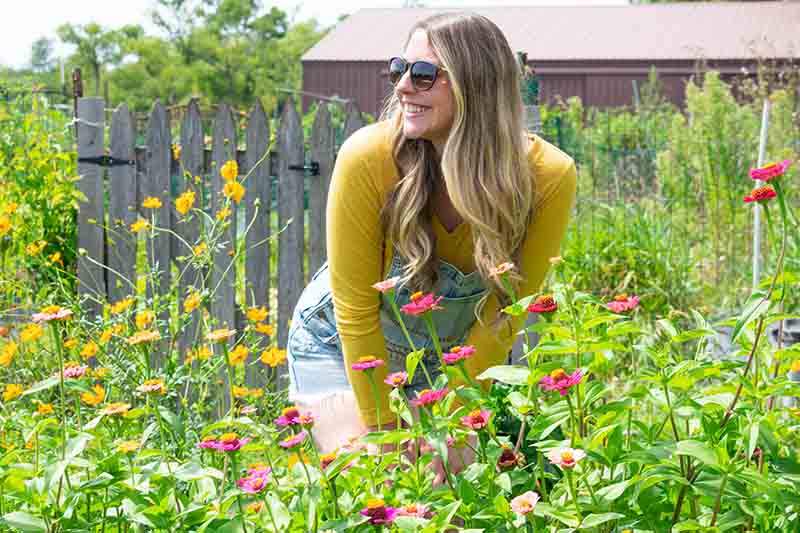
By the end of her first day, she had wilted like a water lily in the desert.
Unfortunately, this is a story I’ve seen repeated so many times that it’s become kind of funny.
I’ll make bets with my coworkers, guessing when the new person will first start to crack in the intensity of a Philadelphia summer, and we all get a laugh when they finally admit that they were wrong about the heat.
Anecdotes aside, you can rest assured that the sun and the heat will get the better of you if you aren’t prepared. Luckily, we’ve got our handy-dandy guide for you to read through and learn from!
Armed with these tips, you’ll be prepared for whatever the summer throws at you.
The Basics of Sun and Heat Protection
Unlike almost everything else in the gardening world, figuring out how to provide adequate sun and heat protection for yourself is an easy-to-nail-down course of action that you can follow.
When dealing with the sun, you have a few definite boxes to check off to ensure you’re prepared:
1. Do You Even Need to Be In the Sun?
The easiest item to check off of this list is: do you even need to be in the sun?
Finding a shady spot where you can work is vital to getting through a long day of gardening work in the hot months of summer.
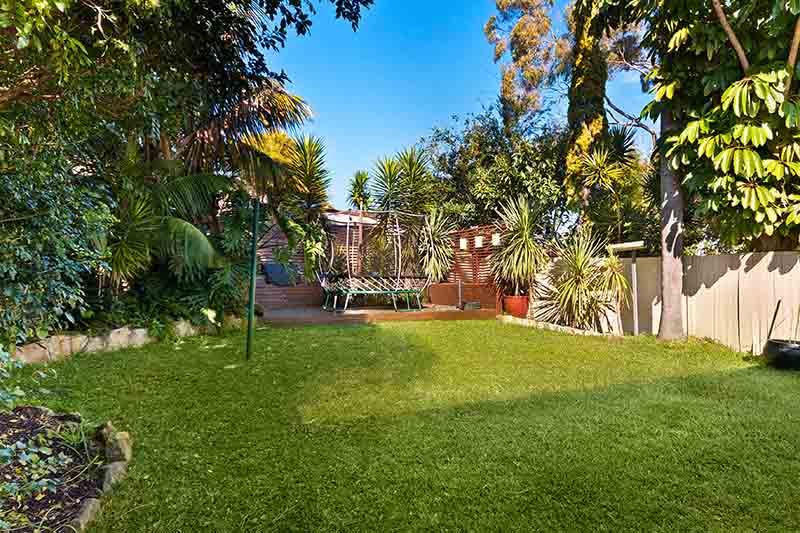
If you can get out of the sun entirely and under the protection of some tall shade trees, you’re off to a great start!
Working strategically around your garden following the shade also orients you to what areas of the garden get the most – or the least – amount of sun.
You’ll know every nook and cranny of your garden in no time, and you might even discover areas that you thought were full-sun locations are in fact in the shade for part of the day.
Also consider the option of staying out of the sun altogether between the hours of about ten and two, when the sun is at its strongest.
I’m outside from seven in the morning until five at night professionally so I don’t have a choice in this matter, but you do.
The savvy gardener gets their watering done in the morning, and the rest of their work done in the evening. By default, if you follow this pattern, you’re outside during the most comfortable times of the day, when the sun isn’t directly overhead.
2. Stay Hydrated
Keeping well-hydrated is absolutely vital when we’re talking about sun and heat protection.
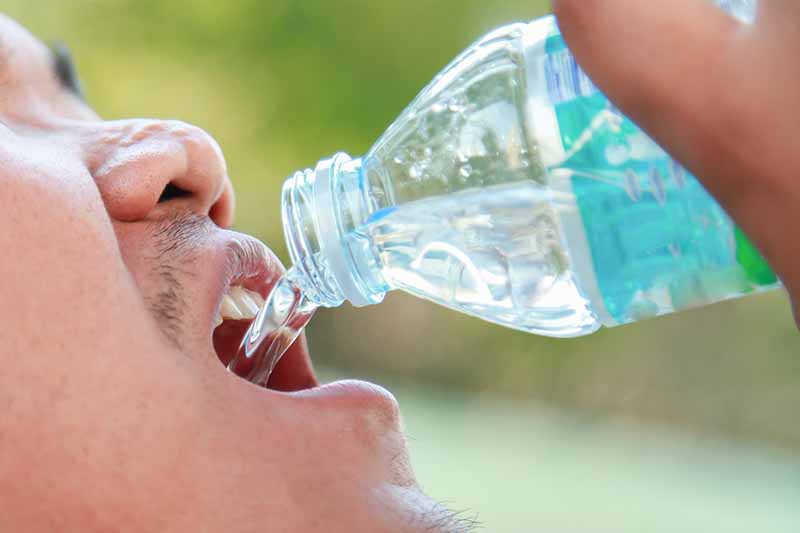
Although we’re generally supposed to drink eight 8-ounce glasses of water a day (64 ounces total), when you’re out in the heat you’ll probably need more than that.
I routinely run through 64 ounces of water by lunchtime.
Drink plenty during the day, and don’t be afraid of nibbling on some pretzels or other salty snacks. A bit of sodium is necessary for our body to keep our electrolytes in balance with all that water we’re drinking, so some light snacking isn’t a bad thing.
3. Wear Some Physical Protection
If you are unable to work in the shade of tall trees, then you need to figure out how to put on – or create – a physical barrier between you and the sun’s harmful rays.

From umbrellas to long-sleeve shirts and pants, to a good old fashioned floppy gardening hat, physical barriers keep the sun off your skin and help to keep you from overheating.
Hats: Put a Lid on It
Baseball caps are great in their own way, but nothing beats the function and style of a wide-brimmed hat.
I’m a fan of straw hats because of how light and airy they are, but a good-quality sunhat is a worthwhile investment.
Search for a hat with a brim that is at least 3 inches wide. Four inches is even better.
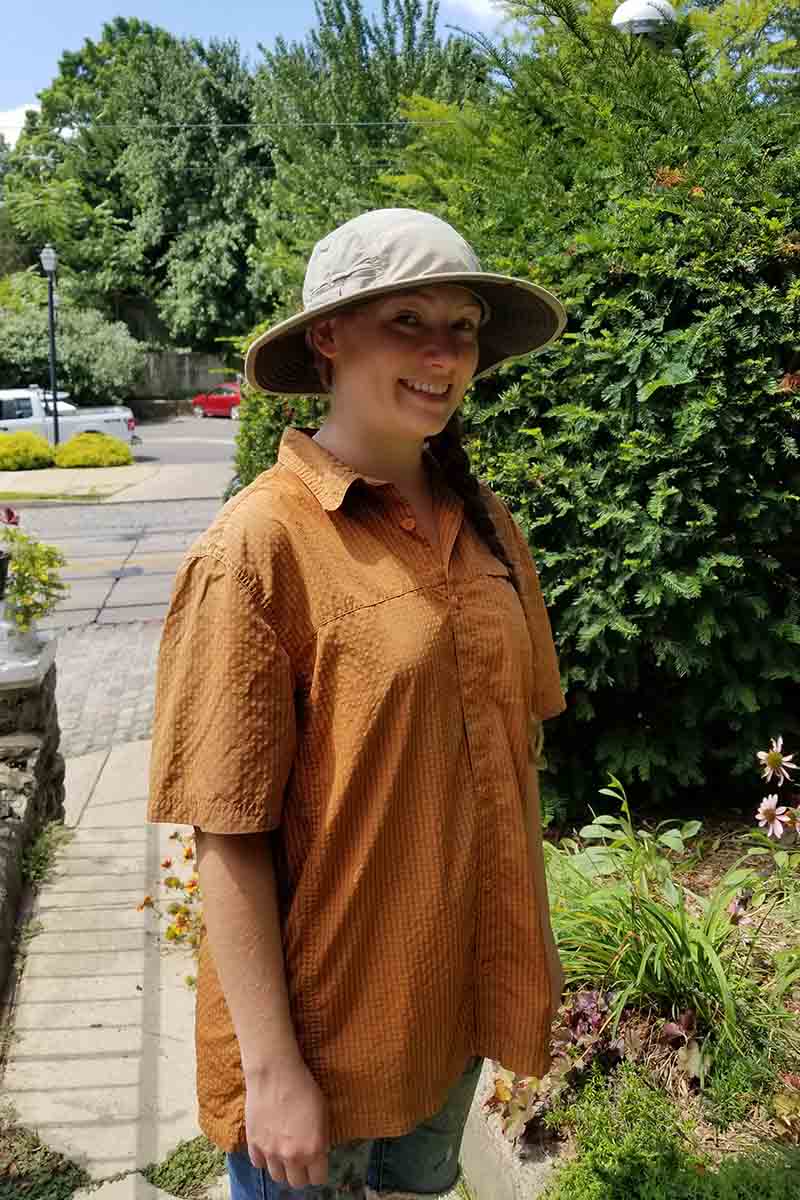
Your goal is to keep the sun off of your face, neck, and anywhere else that it’s possible to cover, so a wide brim will provide an easy solution.
Wearing a baseball cap-style hat is well and fine, but consider wrapping a bandanna around the back of your neck to keep the sun from beating directly on it.
Some hats will include a desert-dweller-style cloth to go over the back of your neck that acts as a shade cover. I’m not a fan of this style myself, but many people are, simply because it works so well!
I like to pick up a new version of my favorite straw hat every summer, and I always get the most out of the few bucks I spend on it.
On the hottest days, I’ll put a bandanna over my neck too, to provide extra protection from those rays.
Long Sleeves? Yes, Long Sleeves!
Pairing a thin and loose long-sleeved shirt made from breathable material with light, breathable pants can make a huge difference in the heat.
Not only is the sun damaging and potentially dangerous to your skin, direct exposure also makes you hotter. By wearing a protective barrier, you’re guaranteed to shave a few degrees off the day.

Does wearing more seem counterintuitive? Think about the image of desert-dwelling people wearing layers of loose-fitting clothing in the blistering heat.
The clothing creates an air pocket that acts like a layer of insulation between your skin and the sun, helping to regulate your body temperature.
Loose clothing also allows for some airflow so that perspiration can evaporate, keeping you cool and comfortable.
4. Wear Sunglasses (or, To Be Cool You Must LOOK Cool!)
A good pair of sunglasses offers a world of protection for your eyes. And that’s a good thing, because your eyes are extra sensitive to UV rays.

The thin skin around your eyes is easily sunburnt, and according to the Skin Cancer Foundation, exposure to UV light can damage the eyes, contributing to macular degeneration, cataracts, and conjunctival cancer.
Always choose a pair that blocks out 99%+ of UV rays and at least 75% of the light from the sun. You can get away with less, but taking good care of your eyes is a worthwhile investment.
I buy safety glasses that meet these criteria and offer the additional protection of impact absorption.
5. Wear Sunblock
I resisted wearing sunblock for most of my life, but boy do I feel silly about that now.
While sunblock doesn’t do much to cool you down, it does offer necessary protection from the sun’s rays.
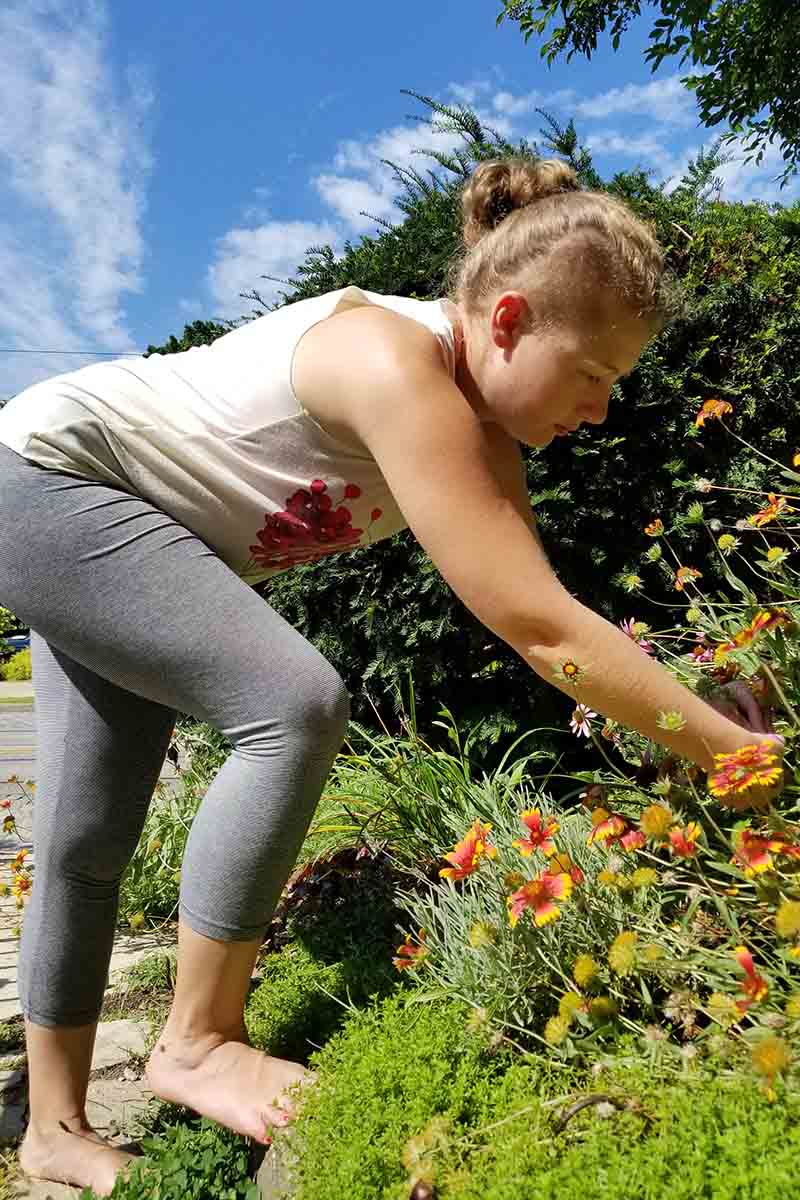
The cream types are much more effective than the spray type since it’s easier to see and control where you’re applying them – and prevent accidental inhalation.
Spray bottles can be useful for reaching spots like the back of your ears, or that bald spot on the top of my head (it gets hot up there).
If you are using a spray, make sure you do so in a well-ventilated area.
When you are shopping for sunscreen, you’ll also find you’ve got a choice between mineral and chemical sunscreens.
The mineral sunscreens contain titanium dioxide, zinc oxide, or a combination of the two. The tiny particles sit on your skin and form a barrier by reflecting the sun’s rays.
Chemical sunscreens work by absorbing the sun’s rays and converting the UV light into heat, and releasing it from the skin.
There is some controversy surrounding the safety of certain ingredients that are often found in these, oxybenzone in particular.
Experts suggest using a combination of both a physical and a chemical sunscreen for maximum protection, but I believe the best sunscreen is the one you’re comfortable wearing.
Choose sunscreen with an SPF of at least 30 for adequate protection, and make sure to reapply it according to the directions on the product, or more often when you get wet or are sweating a lot.
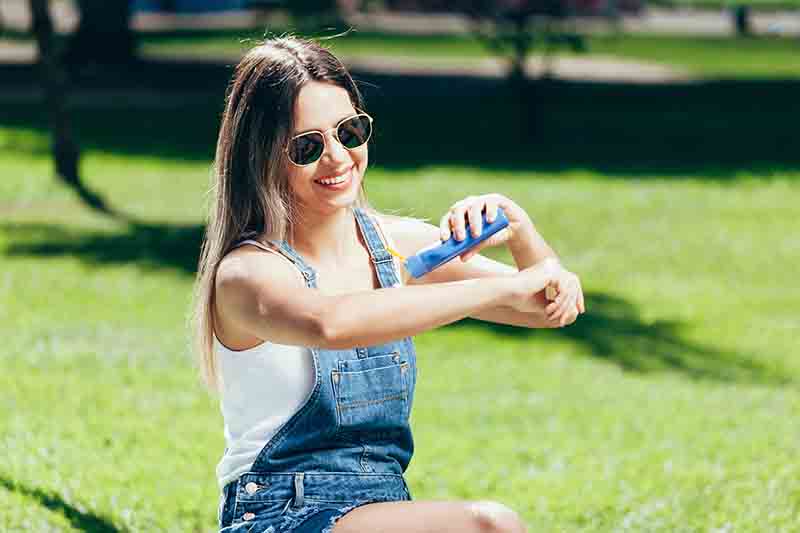
I always keep a bottle of sunscreen in my gardening tote bag, and it usually lasts me for one summer.
Most bottled commercially available sunscreens won’t expire for about three years, but the more the bottle is opened and closed and handled with grubby hands, the faster this expiration date approaches.
Bacteria can enter the bottle and hasten degradation. Cleaning the cap regularly can help prevent dirt and bacteria from getting into it, and potentially causing skin irritation.
As the sunscreen ages, the active ingredients can start to oxidize and lose efficiency. Store your sunscreen out of direct sunlight, and away from extreme hot or cold temperatures. I keep a spare bottle in the trunk of my car with no issues.
All in all, any sunscreen is better than no sunscreen, and even an expired product will provide better protection than applying nothing at all.
Cooling Down When Enough Is Enough
Even with the best gear, you’re probably going to get overheated at times during the day.

So what should we do to avoid that heat stress, and a dose of sun sickness?
Get yourself into a cool and shaded environment and splash some water on your body, or even take a cold shower. That’s my favorite part of coming home after 8 hours in the sun.
How do you know you’ve gotten too much sun or heat?
- Sunburn or flushed skin
- Alternatively cool and clammy skin
- Excessive sweating
- Muscle cramps or nausea
- Headaches, blurred vision, and disorientation
- Vomiting
In my experience, the signs of too much sun or heat exposure start with excessive sweating, then move into a general feeling of exhaustion followed by disorientation.
In my work life I have to deal with mild “sun sickness” as I call it for most of my day, but the moment I start to become disoriented and spaced out, I call it quits and sit in the shade for a while.
Pushing too far beyond these more mild symptoms makes a person susceptible to heat stroke.
The signs of heat stroke include:
- Throbbing headaches
- Rapid pulse
- Red, hot, dry skin
- Losing consciousness
- No sweating
Heat stroke is a serious and life-threatening condition. Emergency services should be contacted in the case of suspected heat stroke.
Sunburn can have a nasty habit of creeping up on you, often only revealing itself later in the day.
It can take less than 15 minutes exposure to the sun for your skin to burn. If exposed areas start to redden, it’s important to get out of the sun immediately, and apply a cooling “after sun” lotion.
Prolonged exposure can result in severe sunburn that can progress into a serious condition known as sun poisoning.
The symptoms of sun poisoning can include:
- Swelling of the skin
- Blistering
- Headache
- Dizziness
- Fainting
- Nausea
- Dehydration
Make sure you seek medical advice if you experience any of these symptoms after prolonged sun exposure.
If you’re in the garden and just need to cool down a bit, you can soak a bandana in cool water from the hose and wrap it around your neck.
This is a handy trick: your neck is very sensitive to temperature, so applying a cool and damp bandanna to it is going to cool you right down.
Placing a cool, wet rag on your wrists is another good option to provide quick and cool relief.
Now, Get Out into the Garden!
Providing adequate sun and heat protection isn’t rocket science, but there’s more to it than sitting under an air conditioner.
Donning a bit of the right clothing, applying some sunscreen, and drinking plenty of water should be enough to get you through the heat of the day, and protect you from the sun’s harmful rays.
And if it’s too hot and you’re able to work smart, try to stay in the shade and out of the sun altogether!
If you’re like me and you can’t stand the feeling of long sleeves or pants in the summer, that’s alright. I’ll apply sunscreen every hour or two like clockwork, and coordinate my workload so that I’m safely out of the sun as much as possible.
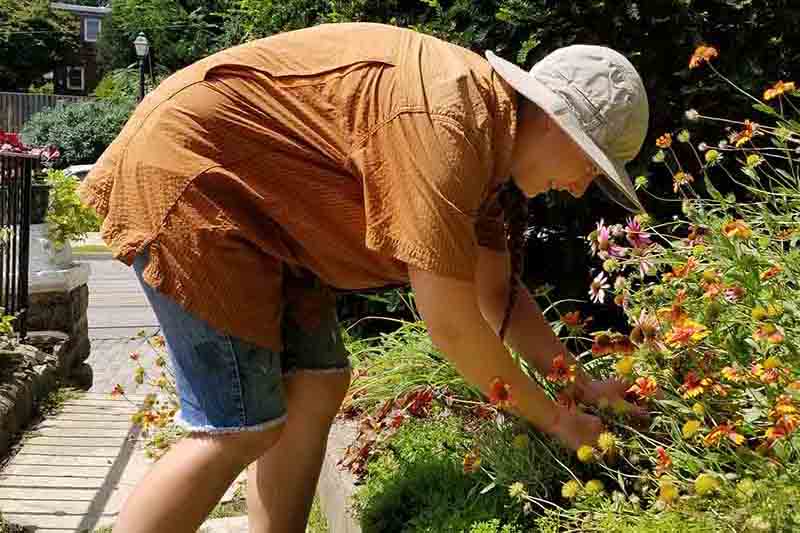
A good quality shirt and shorts and a wide-brimmed hat are standard summer gear for me, along with a bandanna to douse in cold water.
Apply this information to your outdoor lifestyle and you’ll find you feel much more comfortable in the hot weather. Check out our guide to the best sun-protective gear for gardeners for more information.
And don’t forget, as far as I’m concerned, the best way to cool down after a hot day in the sun is with an ice-cold and refreshing five o’clock beverage, such as this tomatillo mojito from our sister site, Foodal. I’ve said it before and I’ll say it again – never trust a sober gardener.
(Of course, please keep in mind that alcohol promotes further dehydration, so pair that cocktail with a few ice-cold glasses of water, please!)
What tips and stories do you have about beating the heat? We’d love to read them in the comments below!
For more great gardening tips why not check out these guides next:
- Your Ultimate Guide to Square Foot Gardening
- Stop Watering Unnecessarily: How to Use a Rain Gauge
- Get Your Garden Off to the Best Possible Start with a Soil Test
Photos by Matt Suwak © Ask the Experts, LLC. ALL RIGHTS RESERVED. See our TOS for more details. Uncredited photos: Shutterstock. With additional writing and editing by Allison Sidhu and Clare Groom
